
THE ABDOMEN IS THE REASON A MAN DOES NOT EASILY MISTAKE HIMSELF FOR A GOD.
—FRIEDRICH NIETZSCHE
The hip flexors just cannot help meddling in the abs’ business.
The rectus or “six-pack” connects your pubic bone to your breastbone. When this muscle contracts, it pulls your pelvis and rib cage together, rounding your back in the process, as in a crunch. This is called “forward spinal flexion”.

Forward spinal flexion.
The psoas major originates on the vertebrae of the lower back, and inserts into the top of the thighbone. When this muscle contracts, it jackknifes the body. When you do a sit-up, you literally pull yourself up by your lumbar spine, which can lead to back problems or aggravate existing ones.

When you do a sit-up, you literally pull yourself up by your lumbar spine.
(The following naïve view is common among the new breed of trainees “enlightened” to embrace integration as opposed to isolation: “I want all of my muscles strong, the psoas as well as the abs!” Fine, but you have to earn the right to strengthen your psoas by making your abs strong enough to balance out its pull. I am not against a strong psoas; I am for balanced strength development.)
Until the recent plank fashion, the “solution” was to avoid hip flexion, or sit-ups, and do only spinal flexion, or crunches. Because there is no hip flexion in the crunch, it supposedly did not involve the psoas and gave the lower back a break. You wish.
Clinicians determined that it is impossible to completely eliminate the hip flexor recruitment during a crunch.19 This is especially true for people with faulty movement patterns and weak abs. A person with weak abdominals relies on his or her stronger hip flexors even during crunches. The trainee cannot get his torso off the floor by rounding his back with his abs, so he compensates by yanking on his spine with his hip flexors to gain momentum! It does not take a rocket scientist to figure out that such training is worthless for the abs and dangerous to the spine. (And even if the person has healthy movement patterns and uses his abs correctly and his hip flexors minimally, the crunch will not allow him to generate enough tension to make it an effective exercise unless he has an exceptional “mind to muscle connection”.)

A weak and/or uncoordinated Comrade will yank on his spine with his psoas even during crunches.
The problem of the hip flexor involvement was radically solved by Vladimir Janda, M.D., from Czech Republic, the consultant on rehabilitation for the World Health Organization and one of the world’s leading experts on back problems, muscle function analysis and evaluation. Professor Janda relaxed the psoas using the neurological phenomenon of reciprocal inhibition. When a muscle contracts, its antagonist, or the opposite number, relaxes. It is about efficiency. The alternative would be similar to stepping on the gas and the brake simultaneously.
Dr. Janda redesigned the sit-up in such a manner that the hip extensor muscles, the hamstrings and the glutes, were activated. Reciprocal inhibition took place and the hip flexors relaxed. The result: back stress was eliminated and the abdominals were “isolated”! The exercise was excruciatingly hard; Joseph Horrigan, D.C. mentions that a number of Olympians struggled to complete even a couple of reps.
I have made modifications to the original. Enter the Hardstyle sit-up.
If you are not a nerd, don’t read this.
The Czech doctor had his patient assume the standard bent knee sit-up/crunch position, placed his hands under the latter’s calves, and gently pulled up. The patient attempted to crunch up while digging his heels into the ground and pushing the balls of the feet downward against the doc’s knees—an isometric calf raise.
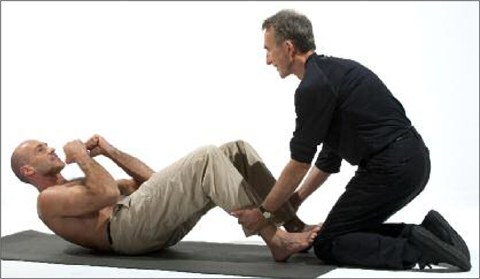
Janda sit-up.
The purpose of digging the heels in was obvious—to recruit the hip extensors and thus inhibit the hip flexors. The toe pushing business was supposed to enhance this process by setting off a muscle synergy present in walking. Or at least so the story went. A later study discovered that Janda sit-ups recruited the hip flexors even more than regular sit-ups…20
Here is what I think went down. The subjects were instructed to pull their feet towards their butts to activate the hamstrings. We know that the hams’ two primary functions are hip extension and knee flexion. Which one do you think they were exercising when they were pulling their heels towards their tails?—It had to be the knee flexion. And the hip action synergistic to it is also flexion.
I can also see how someone who followed Dr. Janda’s original instructions could have gone wrong and pushed up instead of down with the balls of their feet and wedged their heels to formally fulfill the heels down command. The exercise would have practically turned into a conventional feet anchored sit-up.
Whether I am right or not, I have made some changes to Janda’s original sit-up to foolproof it. I called the exercise the “modified Janda situp” and took flak from some medical professionals familiar with the late doctor’s work. They argued that there was not a lot of Janda left in the exercise. Hence, from now on it is the “Hardstyle sit-up”.
My version calls for sitting up all the way. I had expected it to lead to a greater abdominal activation than from just a crunch, as we later confirmed at Prof. Stuart McGill’s lab. A possible explanation: “The hip flexion phase [of a sit-up] provides strong resistance against the abdominals. The hip flexors pull strongly downward on the pelvis as the abdominals work to hold the trunk in flexion and the pelvis in the direction of the posterior tilt.”21
Obviously, a full sit-up cannot be done without the hip flexors. But whatever the physiological mechanism, the Hardstyle sit-up has a remarkable record of building rock hard abs and making backs feel great. Either the hip flexors are not pulling as hard as usual or, more likely, the abs are contracting much harder and balancing out their pull against the spine; whatever it is, it works.
A powerful contraction of the glutes is likely to be giving the back a break.22 And here is another possible mechanism that brings some people with back pain relief when they hit Hardstyle sit-ups. Patients with chronic back pain have difficulty recruiting the internal obliques.23 Research shows that exercises strengthening the IO help people with back pain because of these muscles’ role in stabilizing the spine.24 Our measurements at Prof. McGill’s lab showed peak recruitment of the IO reach 100% maximal voluntary contraction (MVC) during Hardstyle sit-ups. Perhaps this exercise wakes up this muscle in folks with a dysfunctional firing pattern?
Whatever the mechanism, Hardstyle sit-ups deliver.
“MY CHIROPRACTOR TOLD ME THAT I SHOULD BUY THIS [DEVICE] AND STOP DOING SIT-UPS. I HAVE BEEN USING THE AB PAVELIZER FOR 2 WEEKS (EVERY OTHER DAY) AND MY BACK PAIN IS GONE. I AM ALSO STARTING DOING THE BACK STRETCHING EXERCISES THAT
WERE INCLUDING IN THE PACKAGING AT THE SAME TIME.
ACCORDING TO MY CHIROPRACTOR IT IS BOTH OF THEM THAT ARE HELPING ME. SO I WILL STAY WITH IT.”
But first, let us stretch your lower back (provided you are not flexion intolerant). Dr. Janda observed that some of his patients felt back tightness during the abdominal exercise and stretching took care of it.
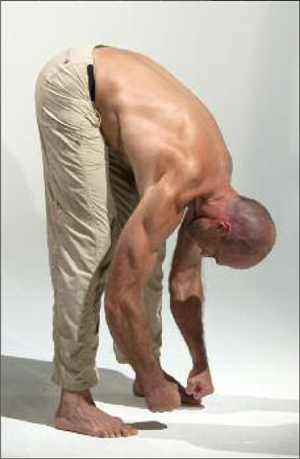

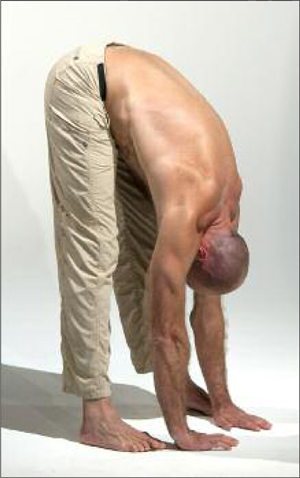
Relax into Stretch back and hamstring stretch.
Always stretch barefoot. Keeping your knees nearly locked, slowly bend over as far as you can. Relax your head, don’t hold it up. Look at some spot behind your knees, not between your feet.
Inhale, grip the ground with your toes, and tighten up the muscles on the rear side of your body: your back, glutes, and hamstrings. Imagine your body is a tightly clenched fist. Indeed, clenching your fists will help.
Hold the tension—and your breath—for a second, then suddenly relax and let the air out with tension. You will drop an inch or two increasing your stretch. I like the graphic description of this tension/release sequence by Dr. Judd Biasiotto: “You must relax instantly... picture yourself exerting all your strength in an effort to push a large boulder off a sheer cliff. When suddenly the boulder goes over the edge, there is no active resistance to your pushing and all your straining instantly ceases. It is that feeling, that nothingness after the boulder drops, that you are striving to obtain when you “turn off your source of power”.
Sigh with relief, and repeat. Make sure not to decrease the stretch when you are tensing and inhaling—stay at the same level.
When you can no longer increase the range of motion, bend your knees, and stand up tensing your glutes. Bending your knees on the way up is essential for your back safety.
Are you ready for the Hardstyle sit-up? Although it looks innocent, it is shockingly tough. Like the bodyguards of the Soviet leaders: regular looking guys without bull’s necks, enlarged knuckles, or scars. They wore nice suits and knew how to use fancy silverware at a state reception. Behind harmless and inconspicuous exteriors hid deadly skills.
The Hardstyle sit-up demands a training partner or some hardware. Let us start with the partner version. Assume the top of the standard bent knee sit-up position, your knees at a ninety-degree angle and your feet flat. Ask your training partner to pull on the very middle of your calves with a towel. He will be tempted to use his hands; do not let him as this will allow him to unconsciously help you cheat! Tell him to pull up at a forty-five degree angle. Ten pounds of force will do in the beginning. You will optimize it later. Do not wear clothes which would slide easily on the surface on which you are exercising. None of that sissy Lycra.
Russian research demonstrated that an eccentric contraction followed by an isometric contraction produced the greatest muscle tension25. So you will start your Hardstyle sit-up from the top down. EMG studies by UCLA professor Dr. Laurence Morehouse, who designed strength and conditioning programs for NASA astronauts, confirmed that this applies to abdominal activation in sit-ups.

Hardstyle sit-up starting position.
The exercise looks deceptively innocent.
On the top of the Hardstyle sit-up your lower back should be slightly flexed and your pelvis slightly tucked in. Slightly—do not force either. Inhale, perform the karate navel maneuver, tense your glutes, and press your feet down into the deck. Hardstyle breathe in a familiar series of sharp hisses until you have emptied most of your air and got a nice cramp in the abbies. Your final hiss should be as sharp as a cough26 or a karateka’s “Kiai!” Dan John half jokingly says that there is no better ab work then vomiting. Strive for that feeling—without the help of undercooked chicken.

To get an even greater contraction, use the following technique.27 Reach your hands forward and place one hand on top of the other. Keeping your shoulders down press the hands hard against each other (if you understand how to externally rotate your shoulders and depress your scapulae, do that too). This will stiffen your lats and light up your whole midsection. Don’t reach forward by rounding your shoulders (you will be tempted to when the going gets tough). You will discover that you have to use various upper back muscles to keep your shoulders in line.



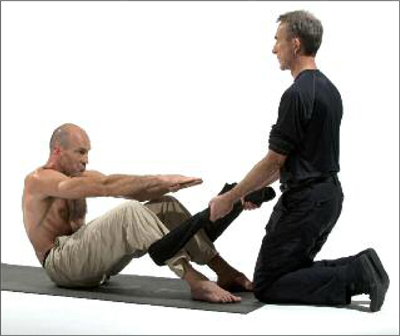
Don’t reach forward by rounding your shoulders when the going gets tough. Use your upper back muscles to keep your shoulders in line.
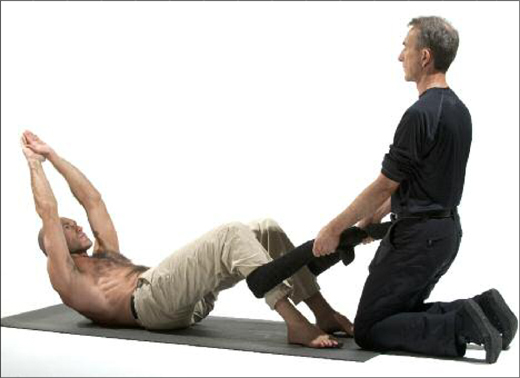
When you get really strong, you may make the Hardstyle sit-up even tougher by keeping your arms in line with your ears. Keep pressing your palms together.
Lie back slowly. I will qualify what “slowly” means. Not an exaggerated ten second negative, just slow enough to eliminate all momentum and maximize tension. If you are strong enough to get all the way down to the deck, it takes approximately three seconds—the same time as it would naturally take you to go back up in a very challenging repetition. In Hardstyle strength training we move the way one moves under a very heavy load—with the unrushed confidence of a tow truck, not exaggerated slowness. Avoid the following bad habit: hitting a sticking point about halfway down and, fearful of going deeper, just hanging there forever, and then collapsing. This is not the Hardstyle way.
So lie back moderately slowly without losing any abdominal and glute tension. “Sniff” or, as the late Dr. Mel Siff used to teach, “sip” air, but do not breathe deep as this would make the contraction weaker. “Breathe behind the shield”, as they say in some karate styles. Deep breathing makes muscle tension drop and holding your breath under tension for an extended period of time is unhealthy. “Breathing behind the shield” is a useful compromise. As always, keep your face impassive, your neck and traps relaxed. You will not be able to totally relax them but do your best.
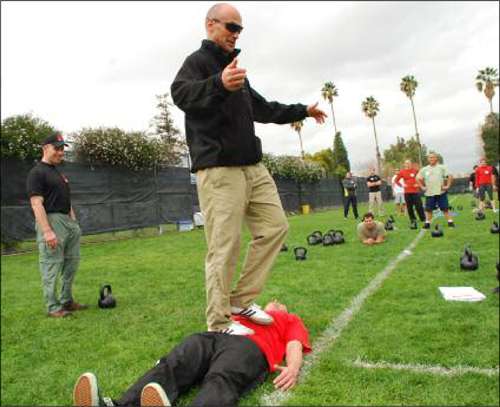
Here is how we teach “breathing behind the shield” at RKC kettlebell instructor courses.
Keep digging your heels down into the ground against your partner’s towel pull. Your feet may neither come up nor drag closer towards your butt—either would indicate cheating with your hip flexors. Ditto if your body is sliding towards your feet. Keep cramping those glutes!
When you have reached the depth where you cannot continue downward without letting your abs and/or glutes go slack, pause for a moment, and slowly power back up. Don’t jerk! On the way up keep “breathing behind the shield”. When you have reached the top, perform the familiar series of Hardstyle hisses until you have explosively emptied your lungs.
Russian research28 showed that the ability to store and reuse the tension loaded into the muscles in the yielding phase of the movement separates elite athletes from the “also-rans”. Visualize your abdominals as rubber bands. As you stretch them on descent, load them with elastic tension. The following quote from Prof. Stuart McGill, although taken out of context, should drive the point home: “The abdominal wall functions like a spring and should be trained that way.”
Do 3-5 reps, then rest for 3-5min.
Lie back slowly.

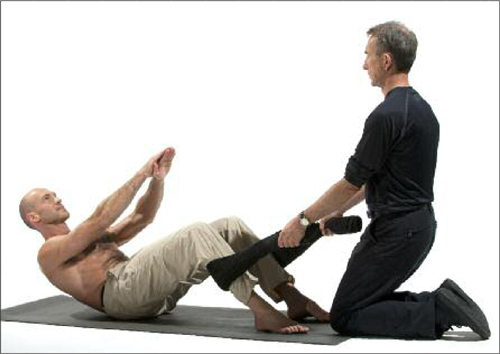
Reverse the movement before you lose tension and collapse.
One more time: keep cramping your glutes, don’t release them for a moment.
If your calves cramp, ignore them. Provided you are well hydrated and your electrolytes are where they need to be, they will adapt in a few sessions.
On your next set add a subtlety that will make the drill more neck friendly. Use Stuart McGill’s imagery and “picture the head and neck as a rigid block on the thoracic spine”. In other words, from your sternum up you are an insect, with no mobility whatsoever! In reality, you will not be able to avoid all movement in the area, just do your best.
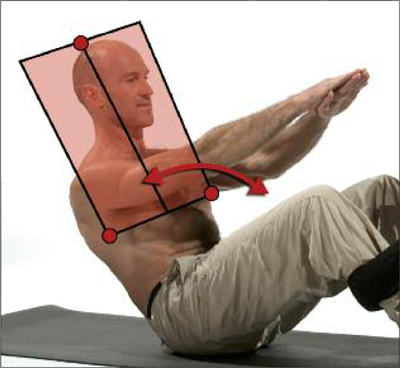

Visualize the part of your body from the sternum up as one rigid block and focus on lifting your sternum off the ground, up and somewhat towards your feet.

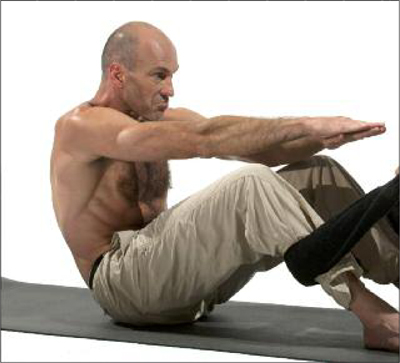
Start by saying farewell to the common practice of initiating a sit-up by tucking in your chin and curling up your upper back. Then tell yourself that you are not a chicken and swear off from jutting your chin forward as well. Visualize the part of your body from the sternum up as one rigid block and focus on lifting your sternum off the ground, up and somewhat towards your feet.
Once more: the focus is on lifting the sternum. Although your neck will not budge, shoot your eyes down between your feet; this will reflexively amplify the abdominals’ contraction. Keep contracting your glutes. Learn to fire your glutes and abs as one muscle—this is one of the secrets of gymnasts’ upper body strength.
You might ask: what should the pelvis and lower back do?—If you follow the instructions and cramp your “cheeks”, keep your feet in place, and move with confident slowness, this area will take care of itself. Your spine will flex and your pelvis will tuck in or tilt posteriorly—just the right amount. Eventually, as you get more coordinated, your glutes and the pelvis will feel like a smoothly rolling, fully pumped up tire.
Do not force either the flexion or the tilt! Remember Cosgrove.
I am warning you: this is boring stuff. Feel free to skip it and do another set of Hardstyle sit-ups instead.
Just to make sure that we are on the same page, the “neutral” pelvis refers to the position it is in when you are standing upright. If you think of the pelvis as a bowl and then tilt it and dump some soup onto the front of your pants, you have an anterior tilt. If the soup spills into your back pockets, the tilt is posterior.
Leading sports scientists Drs. Verkhoshansky and Siff explain:
The pelvis plays a vital role in the ability of the athlete to produce strength efficiently and safely, because it is the major link between the spinal column and the lower extremities… a neutral pelvic tilt offers the least stressful position for sitting, standing and walking. It is only when a load (or bodymass) is lifted or resisted that other types of pelvic tilt become necessary. Even then, only sufficient tilt is used to prevent excessive spinal flexion or extension… The posterior pelvic tilt is the appropriate pelvic rotation for sit-ups or lifting objects above waist level. Conversely… the anterior pelvic tilt is the correct pelvic rotation for squatting [and] lifting heavy loads off the floor”.29
Translation: generally you want to do with your spine and pelvis the opposite of what the load wants them to do. When you are picking up heavy iron off the platform, the barbell wants your back to round and your pelvis to tilt posteriorly. Hence weightlifting coaches keep barking at their athletes to arch and lift their tails. On the other hand, when you are doing a handstand, sit-ups, or any other abdominal exercise involving hip flexion, your spine is determined to go into hyperextension and your pelvis wants to tip anteriorly. This is why gymnastics coaches yell at their charges to tuck in their tails and fight the “banana” shaped arched handstands every bit as ruthlessly as their weightlifting colleagues fight round back cleans. Gymnasts also use this alignment—a posterior pelvic tilt with a maximal abdominal and gluteal tension—in a great many strength maneuvers like the iron cross. Because this so-called “hollow position” (see the photo) makes them super-strong. (The hollow position has nothing to do with TVA hollowing, by the way!)

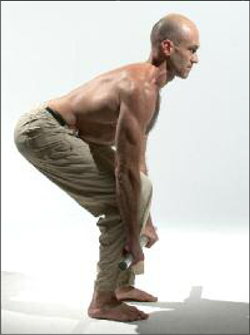

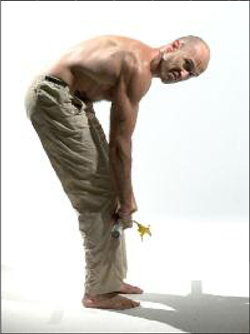
The right and wrong pelvic tilts for lifting weights off the ground.

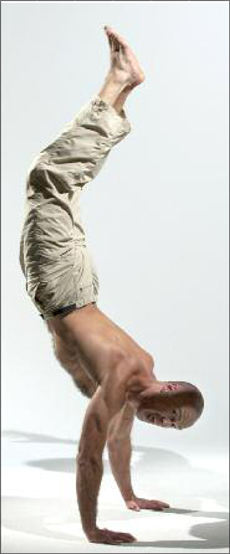

The right and wrong pelvic tilts for the handstand.
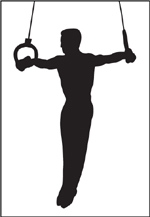
It must be noted that while these weightlifting and gymnastic maneuvers greatly improve strength and safety in their respective disciplines, you should not “live in your sports posture”, as Master RKC Mark Reifkind warns us. If your training molds your body in such a way that you start walking around with a big arch in your lower back and your tail perking up—as many Americans, couch potatoes and athletes alike, do—you are going to be a hurting unit. Elite sprint coach Barry Ross reveals the mystery of the ever-popular hamstring pull: “The anterior pelvistilt can cause irritation to the sciatic nerve as well as hamstring strains or tears. Coaches and athletes often believe that sore hamstrings are the product of lack of stretching, when in fact the hammies are being hammered by the effects of an anterior pelvic tilt. Well-developed abdominal muscles are a necessity to correct the problem.” Add back problems to the list of the joys of living in an anterior pelvic tilt.
Corrective work for this condition includes strengthening the abs and the external obliques, waking up the glutes, and stretching the back muscles and the hip flexors. The Hardstyle Abs plan covers all of the above and your doc is very likely to give it two thumbs up. It is worth noting that 85% of men and 75% of women live with an anterior pelvic tilt!30
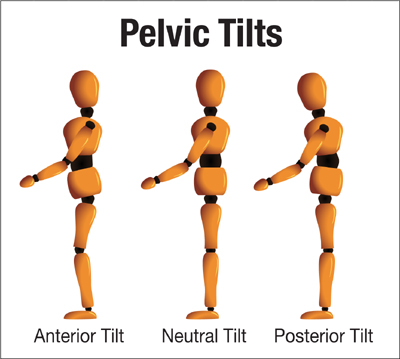
If, on the other hand, your genes and life have given you a posterior pelvic tilt—6% of men and 7% of women31—and a flat spine, you should hold off the Hardstyle Abs plan until you have addressed your condition with a professionally designed corrective exercise plan. Once you are back to plumb, a balanced training program, which involves Hardstyle kettlebells, is in order.
Living with a posterior tilt and a flat spine is not a dream either, because prolonged flexion sets one up for various back and neck problems. But you have to go into this position briefly if you are to train your abbies to the max. Full disclosure: world’s top spine biomechanist Prof. Stuart McGill is not a fan of spinal flexion. According to his research, this is a common lower back injury mechanism, which is why his torso training prescriptions involve only exercises with an immobilized neutral spine. If you are what specialists call “flexion intolerant”, the Hardstyle Abs plan, with a possible exception of Hardstyle breathing, probably is not for you. Get McGill’s classic Ultimate Back Fitness and Performance from www.backfitpro.com and follow the good doctor’s lead.

McGill acknowledges that everyone has different levels of spine flexion tolerance.32 If you can take it and want world-class abs, read on.
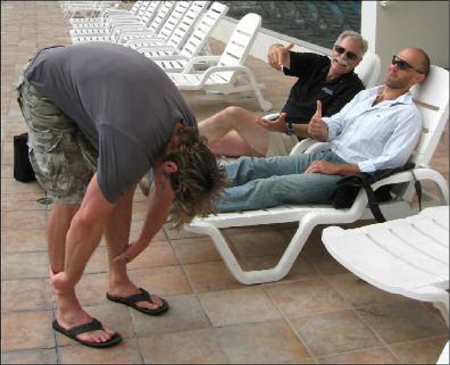
Chad Waterbury demonstrating the type of spine flexion to avoid to Stuart and Pavel. Photo courtesy Chad Waterbury
This is a good time to explain why spine flexion and posterior pelvic tilting are present in Hardstyle Abs.
There are at least three reasons to flex the spine if you are to build the strongest abs.
First, Russian scientists, while endorsing isometric training, have concluded that you will not reach your strength potential if you use it exclusively. A combination of holding, lifting, and lowering is called for.33
Second, one of the goals of the Hardstyle Abs program is myofibrillar hypertrophy of the midsection muscles. Research and experience show that isometric training is an inferior modality for building muscle.
Third, for all their pretty boy side effects, the Hardstyle Abs’ primary goal is strength. Strength is tension. In my coaching experience, one cannot achieve the greatest level of tension without shortening the muscle. And when the abs and the external obliques shorten, the spine flexes and the pelvis tilts posteriorly. Indeed, the posterior pelvic tilt has a very powerful effect on activating the abs.34 To give you an idea, the rectus abdominis were clocked as being 57% more active with a posterior pelvic tilt than an anterior tilt, with a neutral pelvis being in the middle.35 (In the rectus femoris, a hip flexor muscle, the order was predictably the opposite.36) A posterior pelvic tilt elicits a greater activity in the lower abs than spine flexion.37 Emphasizing spinal flexion recruits the upper abs more and emphasizing the posterior pelvic tilt lights up the lower abs more.38 Both are present in the Hardstyle sit-up.
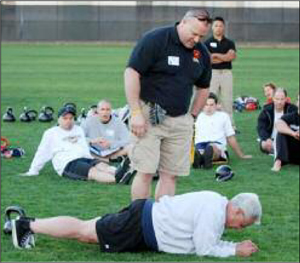
USAPL National Champion and IPF Powerlifting Team USA Head Coach Dr. Michael Hartle, Senior RKC is kicking Masters’ IPF World Champion Doug Dienelt, RKC to test the latter’s plank.
Even if your sport does not demand spinal flexion, once you have trained your abs in flexion—properly, the Hardstyle way—they will be able to generate a lot more tension even with a neutral spine. After a few months of Hardstyle Abs try the plank and you will be blown away by the amount of tension you can generate. And you will be able to hold the neutral posture much better.
Stretch your “dear abbies”, rest for 3-5min—no less!—and do another set. 3-5 sets of 3-5 reps with 3-5min of rest is a standard Hardstyle strength practice. Do this three times a week.
Eventually—if you remember to keep your glutes tight!—you should reach the point where your shoulder blades and the back of the head brush the floor. Congratulations! But this should not stop you from occasionally doing the easier version of your early Hardstyle days—top half reps—for a change of pace and a greater contraction. You may also use the “1½” technique alternating half reps and full reps: down halfway, up all the way, down all the way, up all the way, etc.


The eventual goal is to descend with tension until your shoulder blades and the back of the head brush the floor.
At some point you should add a tougher Hardstyle sit-up variation, which has you start your reps on the bottom. From a relaxed supine position fire your glutes and abs, pressurize, and come up under control, as usual. Blow out your air on the top, get a good abdominal cramp, and head down “sniffing” air a little. When your scapulae and the back of your head touch the ground, let out a sigh of relief and relax completely for a second or more. Then take a breath, reengage the tension, and continue. As we will see later, this practice of creating tension out of nothing is very valuable in your strength practice, which is why it is present in the methodologies of elite strength coaches like Marty Gallagher.

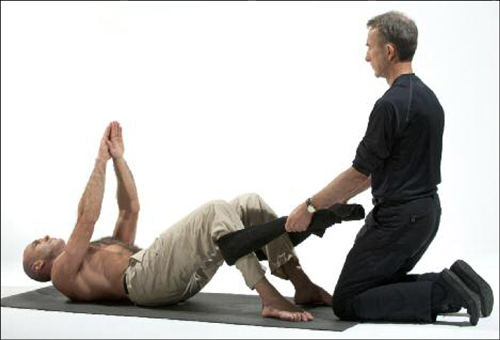
A more challenging dead start Hardstyle sit-up.
Just in case you don’t have a handy training partner, I designed the trusty Ab Pavelizer™ (US Patent No. 6,991,591 B1). Please do not take this as a sales pitch: the Pavelizer works a lot better than a human.
Place your Ab Pavelizer™ on a high friction surface, e.g. a yoga mat. Slap on a barbell plate—10 pounds is a good start—and sit on the ground in front of this deceptively innocent looking device. Spin on your butt and place your calves on top of the roller pads. Press down until your feet are on the deck.

Getting ready to Pavelize your abs”
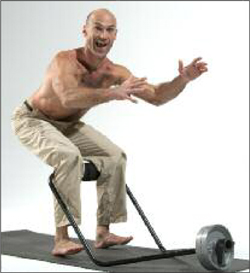

This is how inspector Clouseau would have done it.
Don’t get in position by stepping inside the frame and sitting back! You would be asking for an inspector Clouseau moment.
You know the drill; proceed.

The Ab Pavelizer™ Hardstyle sit-up.
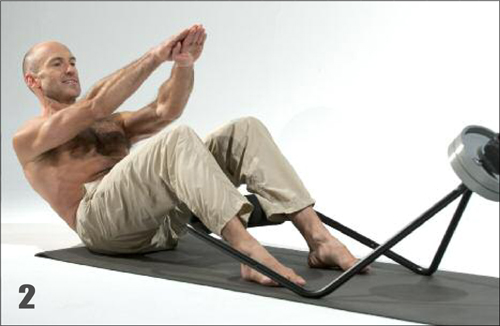
The device provides two types of feedback warning that you are doing the exercise wrong. You could get tricky and try to use your hip flexors by pulling your knees towards your chest. But the moment you do, the Ab Pavelizer™ will slide across the floor towards you. Sirens go off, guns are drawn, you know you had better get your act together!
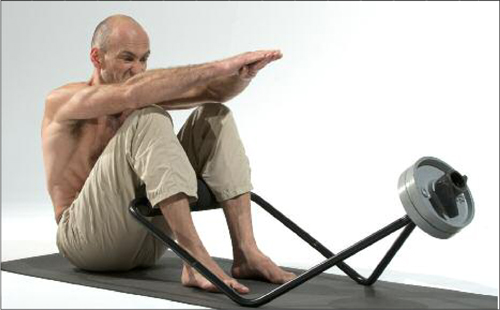

Busted! You are using your hip flexors.
And if you relax your butt muscles even for a moment, the Ab Pavelizer™ that never sleeps will lift your feet right off the floor. Sirens, guns, and the whole unpleasant thing again. So you had better get it right!


Busted! You are not using your glutes.
Progress to the point where you are using 25 pounds if you weigh less than 150 pounds, 35 pounds if your weight is 150-200 pounds, and 45 pounds if you weigh more than 200. Adding weight beyond that is not going to make the exercise any more productive. As long as the counterweight has “taken your legs from underneath you”, you are set.
The required weight will also be affected by your bodyweight distribution. The more top heavy you are, the fewer plates you will need, and vice versa. So don’t be surprised when ladies use more weight. (Another reason not to compare your Hardstyle sit-up performance with someone else’s—your wife or girlfriend will trash you.)
The above numbers are guidelines, not hard rules. Your goal is to eventually find the weight that gives you the most intense abdominal contraction.
The Ab Pavelizer™ is not your typical pretty boy ab machine. Even the first version of the device stopped one of the most famous powerlifters in the world cold at just three reps and most experienced bodybuilders could not do a single one. Measurements from Prof. McGill’s lab show that the Ab Pavelizer™ gets an extraordinary rectus abdominis contraction exceeding 175% MVC (maximal voluntary isometric contraction)! In other words, if you purposefully tense your abs as hard as possible, the Ab Pavelizer™ will make them tense almost twice as hard!
Lab testing the Ab Pavelizer™
Courtesy Prof. Stuart McGill’s Spine Biomechanics Lab at the University of Waterloo, Canada
Following are some readings we recorded. Here is my EMG, with the darkest line indicating the activity of the “six-pack”:
Pavelizer Sit-up—Tense Glutes Bring Tail Bone and Sacrum Together (45lb)

That is some serious recruitment and tension, which directly translate into full body strength and an armored six-pack. Renowned strength coach Mike Burgener, former elite weightlifter and father and coach of elite weightlifters, states: “The Ab Pavelizer is the only device that I use with my athletes to build strong functional abdominals. My athletes range from 16 year-old weightlifters to 74 year-old geezers. We use the Ab Pavelizer in all our workouts. We train abs three times per week and normally hit 3-4 sets of 5-10 reps. I cannot believe the strength we gain in our abs using the Ab Pavelizer… it IS ABSOLUTELY THE BEST AB STRENGTHENER I HAVE FOUND!!! Just hard ass work that really develops the core!!!” Mike is very old school and not prone to exaggeration.
If even a rubber band is not around, do your Hardstyle sit-ups without any equipment. It is below sauerkraut on the food chain—down there with chicken?—but it is better than not doing this powerful exercise at all. When no one and nothing is pulling on your calves you have to really watch out that your lower back does not arch and your abs and glutes are tensed! Specialists warn: “The arching of the back stretches the abdominal muscles, and they may appear firm under tension. The examiner must be careful not to mistake this tautness for firmness due to actual contraction of the muscles.”39 Which is why I do not recommend it to anyone who does not already have the Hardstyle sit-up down pat and abs to kill for. If Ab Pavelizer™ is not an option, hook a rubber band to the doorknob and feed it around your calves. There is a saying in Russia: “Sauerkraut is good to serve with vodka. It is not embarrassing to put on the table, yet it is cheap and you throw away the leftovers with an easy heart.” (It sounds better in Russian.) A rubber band is “sauerkraut”. Experienced gymnast Moses Dungca comments that a rubber band “is just ‘similar’ and not the same thing as the Pavelizer. Again, the PAVELIZER is the finest device I’ve have ever come across. It is what it is and there is really nothing else like it.
Moses adds another reason the Ab Pavelizer™ rules (the italics are mine): “I fully recommend the Ab Pavelizer… It’s the ‘real deal’ and there is nothing like it. It’s evil and it’s supposed to be that way. Trust me, you’ll understand how to truly use and activate your abdominals once you try it. There is nothing like it. AND... I was a gymnast. My abdominals never felt that way before.”
What Dungca refers to is the “reverse engineering of strength” for which my system is known. “Hardstyle”, which is an umbrella term for all my teachings (kettlebell, barbell, bodyweight, mobility, flexibility, etc.), views strength as a skill and reverse engineers the body language of the strongest people in the world. (Thanks to Louie Simmons of the Westside Barbell Club, I can finally explain what I do in one sentence.)

Master RKC Mark Reifkind holding the hollow position with two kettlebells.
Photo courtesy Mark Reifkind
The Hardstyle sit-up reverse engineers a key element of the body language of the athlete with the most spectacular set of abs—the gymnast. Watch him perform an elite ring exercise like the iron cross. You can’t help noticing a Pavelizer like contraction of the abs and glutes.